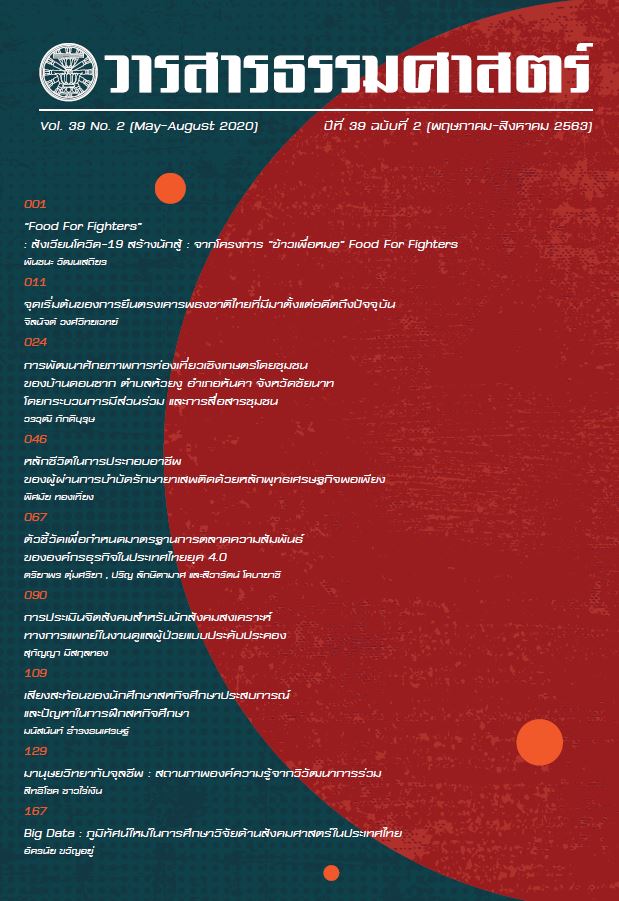Psychosocial Assessment for Medical Social Worker in Palliative Care
Main Article Content
Abstract
Palliative care is an approach that improves the quality of life for end-stage patients and their family for overcoming obstacles with the help of interdisciplinary team. The purpose of this article is to review literature about psychosocial assessment in palliative care.
The result showed that objective of medical social work services is medical support for helping patients and their family adjust and live with well-being. It harmonizes with palliative care approach. Based on medical social work, psychosocial assessment tool has two important characteristics (1) qualitative assessments (2) quantitative assessments. Both tools provide guidelines for assessing patients, their family and social support. Qualitative assessments providing details and evaluations in holistic while quantitative assessments focus on specific factors and scale assessment. It is useful in terms of data processing and statistical summarization. Nevertheless, each type of evaluation has different limitations. The resolution and coverage of the qualitative assessments depend on the skills of the medical social worker and quantitative assessments have limitations on interpretation of questions, lack of questions regarding coping of patients and caregivers, and may not allowed by patients and primary caregiver because their physical conditions are not conducive to answering the questionnaire or unwilling to answer the questionnaire.
The suggestion for psychosocial assessments in palliative care is the combination of qualitative assessments and quantitative assessments. Social workers should qualitatively assess before quantitative assess and repeated qualitative assessments and quantitative assessments to assess in depth and compare change.
Article Details
References
กองยุทธศาสตร์และแผนงาน สํานักงานปลัดกระทรวงสาธารณสุข. (2562). กองยุทธศาสตร์และแผนงานสํานักงานปลัดกระทรวงสาธารณสุข. นนทบุรี: กองยุทธศาสตร์และแผนงานสํานักงานปลัดกระทรวงสาธารณสุข.
กิตติพัฒน์ นนทปัทมะดุลย์. (2557). การประชุมครอบครัวในการดูแลผู้ป่วยระยะสุดท้าย. ในรายงานสืบเนื่องการสัมมนาวิชาการ (Proceedings) เนื่องในโอกาสการสถาปนาคณะสังคมสงเคราะห์ศาสตร ปีที่ 60 เรื่อง “60 ปี คณะสังคมสงเคราะห์ศาสตร์ :คุณค่าของวิชาชีพ และพ ลังสู่การพัฒนาสังคม”, (12-27). กรุงเทพมหานคร: โรงพิมพ์มหาวิทยาลัยธรรมศาสตร์.
กลุ่มงานสังคมสงเคราะห์ สถาบันราชานุกูล. (2559). แบบฟอร์มการสรุปผลงานพัฒนาคุณภาพ ปี 2559. สืบค้นเมื่อ 31 มีนาคม 2563, จาก https://th.rajanukul.go.th/_admin/filedownload/5-5587-1470297627.pdf.
เครือข่ายพุทธิกา. (2561). เผชิญความตายอย่างสงบ. สืบค้นเมื่อ 29 มีนาคม 2563, จาก http://budnet.org/project/โครงการเผชิญความตายอย่างสงบ/.
ชานนท์ โกมลมาลย์. (2560). พื้นฐานสังคมสงเคราะห์สุขภาพจิต. กรุงเทพมหานคร: สํานักพิมพ์มหาวิทยาลัยธรรมศาสตร์.
เต็มศักดิ์ พึ่งรัศมี. (2554). Palliative Care ในประเทศไทย และเครือข่าย Palliative Care ในโรงเรียนแพทย์. ใน ยุวเรศมคฐ์ สิทธิชาญบัญชา, อุมาภรณ์ ไพศาลสุทธิเดช, และศากุน ปวีนวัฒน์, การประชุมระดับชาติการดูแลผู้ป่วยระยะสุดท้าย เรื่อง ความเชื่อมโยงของ การศึกษาไปสู่การปฏิบัติ, (7-20). กรุงเทพฯ: ออฟเซ็ท ครีเอชั่น
พระราชบัญญัติสุขภาพแห่งชาติ พ.ศ. 2550. (2550). ราชกิจจานุเบกษา, 136(ตอนที่ 16ก), 1-18
ปราโมทย์ ประสาทกุล. (2543). ประชากรศาสตร์: สารัตถศึกษาเรื่องประชากรมนุษย์. กรุงเทพมหานคร: อมรินทร์พริ้นติ้งแอนด์พับลิชชิ่ง.
ปรียานุช โชคธนวณิชย์. (2561). การดูแลผู้ป่วยระยะสุดท้ายและครอบครัว: การจัดบริการและ บทบาทของนักสังคมสงเคราะห์คลินิก. วารสารสังคมสงเคราะห์ศาสตร์, 26(2), 108-139.
ราชบัณฑิตสถาน. (2557). พจนานุกรมศัพท์ประชากรศาสตร์. กรุงเทพมหานคร: อรุณการพิมพ์.
สายพิณ หัตถีรัตน์. (2552). ถึงเวลาของฉันแล้วใช่มั้ยหมอ. ใน ประเสริฐ เลิศสงวนสินชัย, อิศรางค์ นุชประยูร, พรเลิศ ฉัตรแก้ว และ ฉันชาย สิทธิพันธุ์, การดูแลผู้ป่วยระยะ
สุดท้าย End of Life Care Improving Care of The Dying, ( 37-39) . กรุงเทพมหานคร: อักษรสัมพันธ์.
สมาคมบริบาลผู้ป่วยระยะท้าย. (2563). ความเป็นมาของสมาคมฯ. สืบค้นเมื่อ 29 มีนาคม 2563. จาก http://www.thaps.or.th/%e0%b8%84%e0%b8%a7%e0%b8%b2%e0%b8%a1%e0%b9%80%e0%b8%9b%e0%b9%87%e0%b8%99%e0%b8%a1%
e0%b8%b2/.
สํานักงานปลัดกระทรวงการพัฒนาสังคมและความมั่นคงของมนุษย์. (2557). ประชากรสูงวัย: ปัจจุบันและอนาคต. กรุงเทพมหานคร: สํานักงานปลัดกระทรวงการพัฒนาสังคมและความมั่นคงของมนุษย์.
อรรถกาญจน์ ธนทวีสกุล. (2556). คุณภาพชีวิตและความต้องการการสนับสนุนทางสังคมของผู้ดูแลผู้ป่วยโรคมะเร็งระยะสุดท้าย. (วิทยานิพนธ์ปริญญามหาบัณฑิต, สาขาการบริหารและนโยบายสวัสดิการสังคม, สังคมสงเคราะห์ศาสตร์, มหาวิทยาลัยธรรมศาสตร์).
Kubler-Ross, E. (2525). ความตายกับภาวะใกล้ตาย (มาลินี วงศ์พานิช). กรุงเทพมหานคร: สํานักงานคณะกรรมการวิจัยแห่งชาติ. (1969).
APHN. (2020). About as. Retrieved March 29, 2020, from https://aphn.org/about-us/.
Baines, M. (2011). From pioneer days to implementation: lessons to be learnt. European Journal of. Palliative Care, 18(5), 223–227.
Institute for Health Metrics and Evaluation (IHME). (2018). Global Burden of Disease Study 2017 (GBD 2017) Results. Seattle, United States: Institute for Health Metrics and Evaluation (IHME).
National Association of Social Workers. (2004). NASW standards for Palliative and End of Life Care. Washington, DC: National Association of Social Workers.
National Clinical Programme for Palliative Care. (2014). Palliative Care Needs Assessment Guidance. Dublin: National Clinical Programme for Palliative Care.
Oliver, D. P., Wittenberg-Lyles, E., Washington, K. T., & Sehrawat, S. (2009). Social Work Role in Hospice Pain Management: A National Survey. Journal of Social Work in End-of-Life & Palliative Care, 5(1-2), 61-74. doi:10.1080/15524250903173900
Omran, A. (1971). The Epidemiologic Transition: A Theory of the Epidemiology of Population Change. The Milbank Memorial Fund Quarterly, 49(4), 509-538. doi:10.2307/3349375
Palliative care Australia. (2020). What is Palliative care?. Retrieved March 30, 2020, from https://palliativecare.org.au/wp-content/uploads/dlm_uploads/2016/05/What-is-Palliative-Care-A4.pdf.
Rakic, M., Escher, M., Elger, B. S., Eckstein, S., Pacurari, N., Zwahlen, S., & Wienand, I. (2018). Feelings of Burden in Palliative Care: A Qualitative Analysis of Medical Records. Journal of Palliative Care, 33(1), 32–38. doi.org/10.1177/0825859717750522
Reese, D. J., Raymer, M., Orloff, S. F. et al. (2006). The Social Work Assessment Tool (SWAT). Journal of Social Work in End-of-Life & Palliative Care, 2(2), 65-95. doi:10.1300/J457v02n02_05
Reese, D. J. , & Csikai, E. L. (2018). Social Work Assessment and Outcomes Measurement in Hospice and Palliative Care. American Journal of
Hospice and Palliative Medicine, 35(12), 1553–1564. doi.org/10.1177/1049909118788342
Taylor, B. (2012). Developing an Integrated Assessment Tool for the Health and Social Care of Older People. The British Journal of Social Work, 42(7) , 1293-1314.
Vallath N. , Salins N. (2017) . Holistic Supportive Care in Oral Cancer: Principles and Practice. In Kuriakose M. (eds), Contemporary Oral Oncology. Cham: Springer.
Veloso, V., & Tripodoro, V. (2016). Caregivers burden in palliative care patients: A problem to tackle. Current opinion in supportive and palliative care, 10(4), 330–335. doi:10.1097/SPC.0000000000000239
Victoria Hospice Society. (2001). Palliative Performance Scale (PPSv2) version 2. Retrieved from http://www.npcrc.org/files/news/palliative_performance_scale_PPSv2.pdf. Accessed March 31, 2020.
Vongvasinkul, P., Punlainak, N., Kijpaisalratana, N., et al. (2018). Chula Stroke selfhelp group: a tool for empowering stroke patient. Neuroimmunol Neuroinflammation, 37(5), 6. doi: 10.20517/2347-8659.2018.45
WHO. (2014). Global Atlas of Palliative Care at the End of Life. London: Worldwide Palliative Care Alliance.
WHO. (2016). Planning and implementing palliative care services: a guide for programme managers. Geneva: World Health Organization.
WHO. (2018). Palliative Care. Retrieved March 26, 2020, from https://www.who.int/ news-room/fact-sheets/detail/palliative-care.

